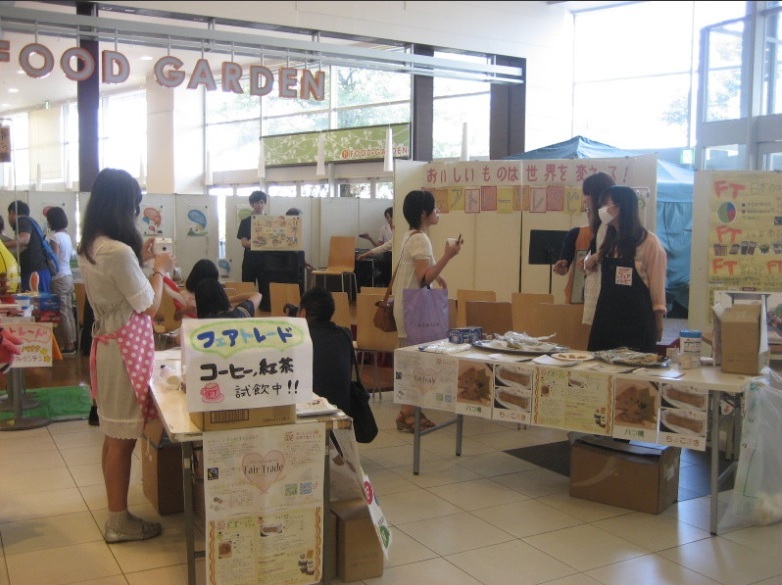Fair Trade market and movement in Japan
CONTENTS
Low awareness about fair trade in Japan
By Florian Kohlbacher and Sara Schmitz
Awareness of Fair Trade Among Youths
On a Sunday morning at 9 am, Sumika Mogi was already up for a while and making her way through Tokyo’s subway system, heading to the weekly meeting of her club, the Fair Trade Students Network (FTSN). This club connects Japanese students who campaign for Fair Trade.
Sumika first learned about Fair Trade at her high school, when a teacher brought some Fair Trade chocolate to class in order to explain the idea of higher wages for producers in developing countries. Today, since the topic of Fair Trade has entered junior and senior school’s text books, the probability that young Japanese get to know about Fair Trade immensely rose.
--What is Fair Trade?--
Fair trade is an organized social movement that aims to help producers in developing countries to make better trading conditions and promote sustainability. It advocates the payment of a higher price to exporters as well as higher social and environmental standards. It focuses in particular on exports from developing countries to developed countries, most notably handicrafts, coffee, cocoa, sugar, tea, bananas, honey, cotton, wine, fresh fruit, chocolate, flowers, and gold.
“Back then, I had neither opportunity, nor time to commit myself to the Fair Trade movement,” Sumika says, “though I would really have liked to support it.” But soon after entering university, she found the student club FTSN to participate in.
Sho Arima, the group leader of Waseda University’s Fair Trade club Cafaire, describes his reasons for spending his free time on the promotion of Fair Trade. “I was looking for some voluntary work I could do to contribute to society. I wanted to commit myself, I wanted to do something. I found out about this club, Cafaire, and I thought that Fair Trade is the perfect way to integrate volunteering in my everyday-life.”
This should be somewhat influenced by the fact that after the Great East Japan Earthquake in March 2011 there is an ongoing trend towards society-contributing actions, especially among younger Japanese.
Spreading the Movement of Fair Trade
Those students see their main task in arousing interest in Fair Trade, but how are they proceeding? There’s a dense plan of action: Handing out free brochures with tips on how to include Fair Trade in a student’s life, holding events like Fair Trade fashion shows or Fair Trade make-up classes and conducting projects like “Machichoco.”
This project starts up with a public design contest. The winner’s painting will be used for the packaging of Fair Trade chocolate bars, which subsequently will be offered at shops on and around the campus. By this, the students both attract attention for Fair Trade and heighten the possibility to buy Fair Trade chocolate. Another early Sunday morning a student activist Sumika was on the train to Chiba Newtown, where she would join other FTSN-members to support a Fair Trade event. It was held in the entrance hall of a big AEON shopping mall. In the shape of a bazaar, various Fair Trade actors such as NGOs, individual Fair Trade vendors and student clubs offered their products. As Sumika arrived, the preparations seemed to be completed and the mall opened up its doors for the Sunday shoppers. “We are handing out flyers with information on the Fair Trade event. Often - after handing out the flyer - we get asked ‘what is Fair Trade?’.”

AEON’s action for Fair Trade goes beyond allocating their mall’s lobby to a Fair Trade event. Among Japanese conventional companies, those connected to the AEON Group are already highly involved in Fair Trade. At AEON supermarkets or convenience store chain Ministop, consumers can purchase Fair Trade-certified products like coffee, bananas or cookies. Their private brand “Top Value” also offers Fair Trade-certified chocolate.
Low Awareness and Uniqueness in Japan
But the awareness of general public is still low. As a recent survey conducted by NTT Communications shows that only 43.8% of the 2,350 surveyed consumers knew the term Fair Trade, this is much less than in the West.
Fairtrade-certified means that a product is certified by the umbrella-organization Fairtrade Labelling Organizations International (FLO). Products which got labelled with the blue-green FLO’s Fairtrade-mark also started to enter Japanese supermarkets, but can’t be considered to have met the mainstream yet and activists are alarmed by Japanese results in international FLO statistics.
According to these statistics a Japanese spent on average 0.15 euro on Fairtrade-certified products in 2011. The latest FLO Annual report that was released just this September features the Japanese data based on a different estimation method. According to this, the per capita fair trade consumption was 0.46 euro in 2011 and 0.56 euro in 2012. This is however still very small in international comparison. The UK’s per capita sales for 2011 obtained 24.06 euro and in Switzerland even 33.29 euro. On the other hand, FLO statistics show that the Japanese year-on-year growth rates are double-digit: a growth of 29% from 2010 to 2011, and another 17% from 2011 to 2012.

However, what should be noted is that a part of the Fair Trade market is not mirrored in the FLO statistics. Sale figures of organisations and companies which are not certified by the FLO, but are either a member of the World Fair Trade Organisation (WFTO) or completely independent, are excluded.
But there is some uniqueness in Japanese Fair Trade market. As one activist of the NGO ShaplaNeer puts it, “Maybe, some customers who pick a Fair Trade product out of a supermarket-shelf don’t choose it for its Fair-Tradeness, they choose by its design or its quality, maybe sometimes even unaware, that it is a Fair Trade product.”
Results of the NTT Communications’ survey speak in the same tone: 70.9% cited “the product itself” as cause for the purchase of a Fair Trade product. That should be one of the reasons why ShaplaNeer has its high quality soap line “She with ShaplaNeer” in a chic package design where the characteristic “Fair Trade” is just discreetly written alongside. These soaps are even displayed in department stores, which is, at the moment, still rather uncommon for Fair Trade products.
This NGO’s thinking is a good example of Japanese Fair Trade activists cultivating the Fair Trade market. Products are starting to meet special Japanese consumer needs, such as in this case, the call for high quality. In a sense, it is simply an essential adjustment, since Fair Trade emerged and grew in North American and European consumer societies. But it’s a completely new approach to Fair Trade. The Fair Trade movement’s both image and products shift away from a taste of “charity” to a case of “quality.” Summarized, more “Japan-style” Fair Trade products are offered in more compelling ways to consumers. Another Fair Trade pioneer supplying Japanese consumers with Fairtrade-certified products is Wakachiai: Since the 1990s the NGO permanently extended its range of products and today Japanese consumers can order products from coffee over roses and textiles to wine via the Wakachiai online catalogue. “We are happy that now we can even offer Fairtrade soy sauce and Fairtrade miso soup,” says the NGO’s head Suguru Matsuki. In the past, there was almost no traditional cooking ingredient available as a Fair Trade product. Today, if you know where to find them, you can do your everyday Japanese cooking with Fairtrade-certified grocery. That’s another example which shows how Fair Trade organizations start to orientate towards Japanese consumer needs behind a significant market growth expected.

.jpg)
